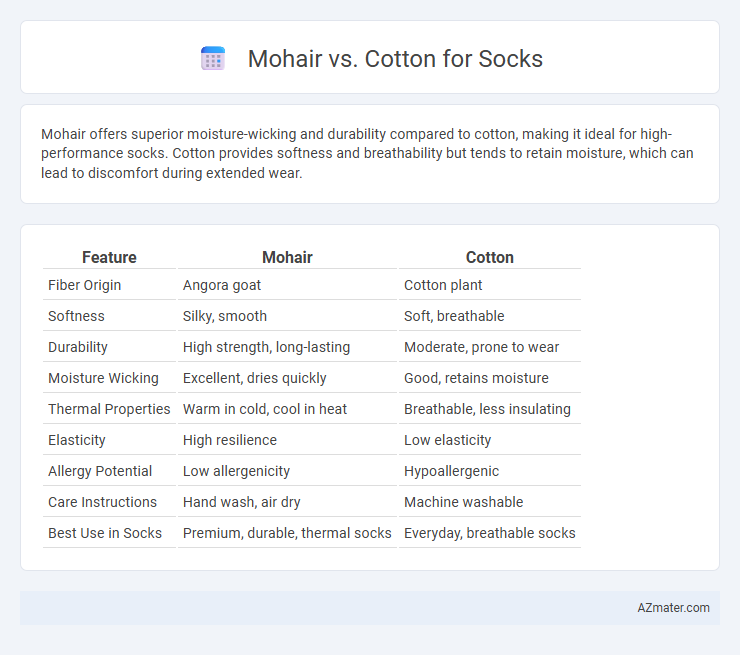Mohair offers superior moisture-wicking and durability compared to cotton, making it ideal for high-performance socks. Cotton provides softness and breathability but tends to retain moisture, which can lead to discomfort during extended wear.
Table of Comparison
| Feature | Mohair | Cotton |
|---|---|---|
| Fiber Origin | Angora goat | Cotton plant |
| Softness | Silky, smooth | Soft, breathable |
| Durability | High strength, long-lasting | Moderate, prone to wear |
| Moisture Wicking | Excellent, dries quickly | Good, retains moisture |
| Thermal Properties | Warm in cold, cool in heat | Breathable, less insulating |
| Elasticity | High resilience | Low elasticity |
| Allergy Potential | Low allergenicity | Hypoallergenic |
| Care Instructions | Hand wash, air dry | Machine washable |
| Best Use in Socks | Premium, durable, thermal socks | Everyday, breathable socks |
Introduction: Understanding Mohair and Cotton Socks
Mohair socks, derived from the silky hair of the Angora goat, offer exceptional softness, durability, and moisture-wicking properties ideal for temperature regulation. Cotton socks, made from natural cotton fibers, provide breathability and comfort but tend to retain moisture, which can lead to less odor control and quicker wear. Choosing between mohair and cotton socks depends on the desired balance of warmth, moisture management, and longevity for everyday or specialized use.
Material Origins: What Are Mohair and Cotton?
Mohair is a luxurious fiber obtained from the Angora goat, known for its silky texture and natural luster, while cotton is a soft, fluffy fiber harvested from the seed hairs of the cotton plant, prized for its breathability and comfort. Mohair fibers are long and strong, offering durability and moisture-wicking properties, making them ideal for high-performance socks. Cotton fibers are shorter and more absorbent, providing softness and easy care, commonly used in everyday sock wear.
Comfort and Softness Comparison
Mohair offers exceptional softness and a silky texture that enhances sock comfort by reducing irritation and providing a smooth feel against the skin. Cotton socks provide breathability and a natural softness but tend to retain moisture, which can reduce overall comfort during extended wear. The superior moisture-wicking and insulating properties of mohair contribute to a consistently cozy fit, making it a premium choice for softness and comfort in socks.
Durability: Which Sock Lasts Longer?
Mohair socks exhibit superior durability due to mohair fibers' natural strength and resistance to wear, making them less prone to pilling and tearing compared to cotton socks. Cotton socks, while comfortable and breathable, tend to wear out faster under consistent use as their fibers are more susceptible to abrasion and thinning. For long-lasting performance, mohair socks provide enhanced longevity, especially in active or outdoor settings.
Moisture-Wicking and Breathability Analysis
Mohair fibers excel in moisture-wicking due to their natural crimp and hollow structure, efficiently drawing sweat away from the skin and promoting quick drying. Cotton, while breathable, tends to retain moisture longer, which can lead to dampness and discomfort during extended wear. For socks requiring superior breathability and moisture management, mohair offers enhanced performance by combining insulation with effective moisture regulation.
Temperature Regulation: Warmth vs Coolness
Mohair excels in temperature regulation for socks, providing superior warmth through its natural insulating properties while remaining lightweight and breathable. Cotton, known for its moisture-wicking ability, keeps feet cool by allowing better air circulation and absorbing sweat efficiently. Choosing between mohair and cotton socks depends on the desired balance of warmth and coolness, with mohair ideal for colder climates and cotton suitable for warmer conditions.
Hypoallergenic Properties and Skin Sensitivity
Mohair fibers, derived from the Angora goat, offer natural hypoallergenic properties that reduce irritation and are ideal for sensitive skin, while cotton, a plant-based fiber, also provides a gentle, breathable fabric known for its softness and low allergenic potential. Mohair's moisture-wicking ability helps maintain a dry environment, minimizing conditions for bacteria and allergens, whereas cotton's absorbency can sometimes trap moisture, increasing the risk of irritation for highly sensitive skin. Choosing mohair socks benefits those prone to skin sensitivities by balancing warmth and breathability with hypoallergenic attributes, whereas cotton socks excel in everyday comfort and ease of care.
Environmental Impact and Sustainability
Mohair production involves raising Angora goats, which can lead to land degradation if not managed sustainably, but its fibers are biodegradable and durable, contributing to longer-lasting socks with less frequent replacement. Cotton cultivation requires significant water, pesticide use, and arable land, resulting in a higher environmental footprint, though organic cotton reduces chemical inputs and promotes soil health. Choosing mohair socks supports sustainable animal fiber options with lower water use, while organic cotton offers a plant-based alternative with improved ecological practices.
Cost and Value for Money
Mohair socks typically cost more than cotton socks due to the premium quality and durability of mohair fibers, which provide superior insulation and moisture-wicking properties. Cotton socks are generally more affordable but may wear out faster and lack the same thermal benefits, making mohair a better value for long-term use despite the higher upfront price. Investing in mohair socks delivers enhanced comfort and longevity, offering greater value for money for those prioritizing performance and durability.
Choosing the Right Sock: Mohair or Cotton?
Mohair socks excel in moisture-wicking and thermal regulation, making them ideal for outdoor activities and cold weather due to their natural insulation and softness. Cotton socks, while breathable and comfortable for everyday wear, tend to retain moisture, increasing the risk of blisters and discomfort during prolonged physical activity. Selecting the right sock depends on the intended use: mohair is optimal for performance and durability, whereas cotton suits casual, low-intensity wear.

Infographic: Mohair vs Cotton for Sock
 azmater.com
azmater.com